50% of prospecting is unproductive.
Think about it – over 90% of the calls your team makes go unanswered. And of the ones that are answered, only 2% actually result in a first meeting. This has only gotten worse in a fully digital world.
Whether you’re a full-cycle AE, a BDR, or an SDR, you’re probably doing plenty of prospecting.
Prospecting can be a lot like my golf game. I hit that one shot where I think maybe, just maybe, I’ve got a chance at next year’s PGA Tour. And then reality hits after the next 20, 30, 40 shots don’t measure up.
It doesn’t have to be like that.
I put together the prospecting strategies our teams use every day (plus some plays you can put into practice tomorrow) to break into target accounts and exceed their quota using Drift.
If listening is more your thing, I also presented these plays on a webinar – you can check out the full recording here. Otherwise, keep scrolling for all the insights💡
Stop Giving Your Teams the Modern Phone Book
Only 60% of sales reps and 48% of SDRs consistently meet their quota.
Today, we give reps and BDRs the modern-day version of a phone book.
Not much has changed since my first sales job 24 years ago. I started out as a BDR and on my first day, I was given a Yellow Pages phone book, a tape recorder, and an order from management to hit 50 dials a day.
Today, so many sales reps do the exact same thing, just with ZoomInfo or LinkedIn Sales Navigator.
We’re still hoping for the best instead of really understanding who we’re targeting, why we’re targeting them, and whether or not it’s actually working. What makes a BDR’s time valuable isn’t the dialing – it’s the conversation.
Given all of this data we have access to in today’s digital selling world, we wanted to make teams more successful with better prospecting strategies and tools.
Drift automatically prioritizes your target accounts, centralizes insight on behavior across the buying team, and gives you direct access to follow up – all from a single interface.
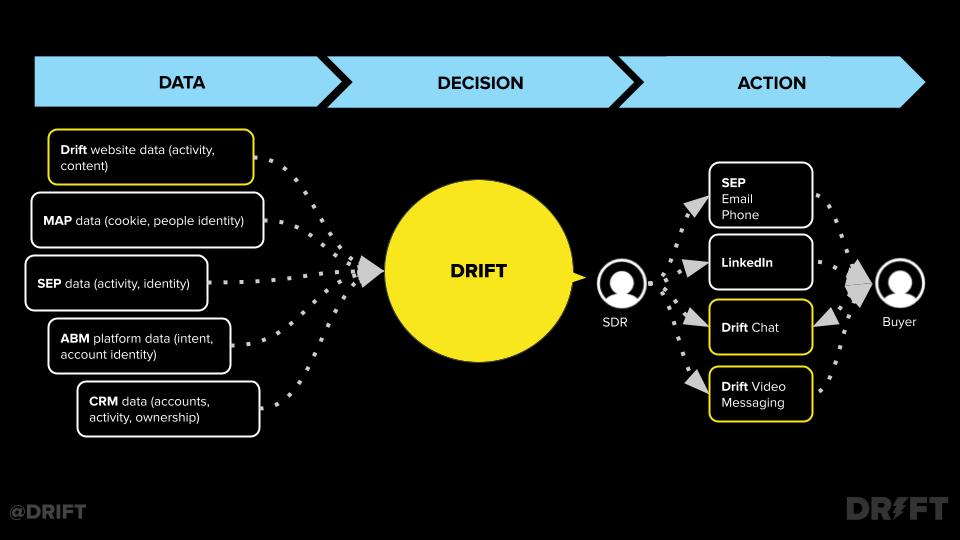
When someone clicks on your website, signs up for an email, or attends a webinar, that’s all one experience to them. But to you, that could be three or four different teams and three or four different databases.
Drift brings all of that under one roof, so you and your team can accelerate revenue and hit your quota faster.
4 Ways to Accelerate Revenue (+ 4 Prospecting Strategies to Steal Right Now)
For most sales organizations, it’s data, data, everywhere, but not a drop to drink.
The data doesn’t matter if you can’t turn it into actions and outcomes.
That’s where Drift can help. We identified four major pain points that real sales teams like mine face every day – and the proven sales prospecting strategies you can use to overcome these challenges and accelerate your revenue.
1. Prioritize Target Accounts
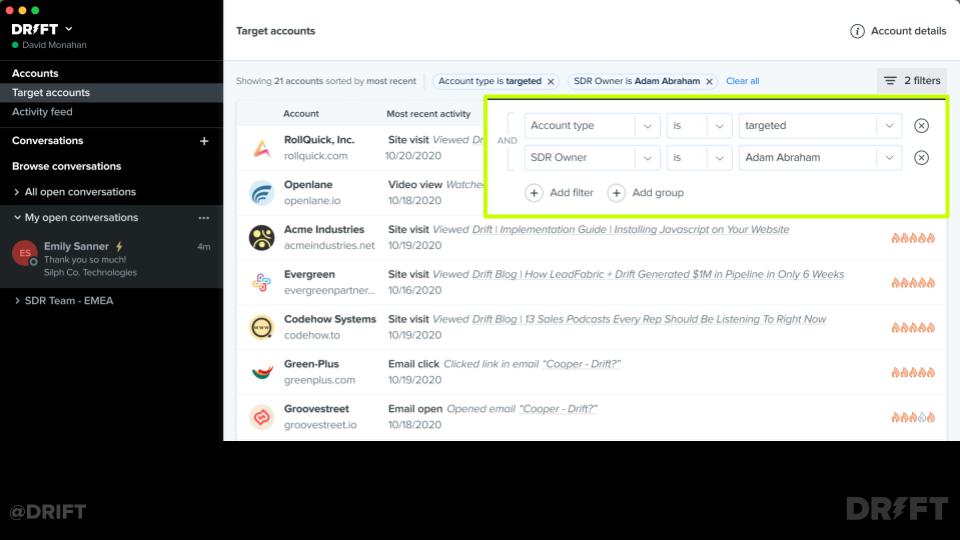
You already know your ideal customer.
But sometimes it can be tricky to prioritize which accounts to look at first, especially if you’re trying to sift through 500 different names, see how well they fit your ideal customer profile (ICP), and determine their engagement level.
So a lot of reps take a section of the list each week and say, “Okay, today I’m starting with A’s.”
Yeah, there’s definitely a better way to prioritize.
With Drift, you can see each account based on where they are in the buyer’s journey. Things like recent activity, website engagement, chat histories, and more, so you can easily identify which ones are going to be your best bets.
Any top-performing SDR has one thing in common: they spend their time on the right activities at the right time.
This empowers your team to go beyond alphabet or intuition to data-driven insights on which accounts are going to provide the most value (and which are hottest right now).
The Prospecting Strategy: Identifying High Potential Accounts
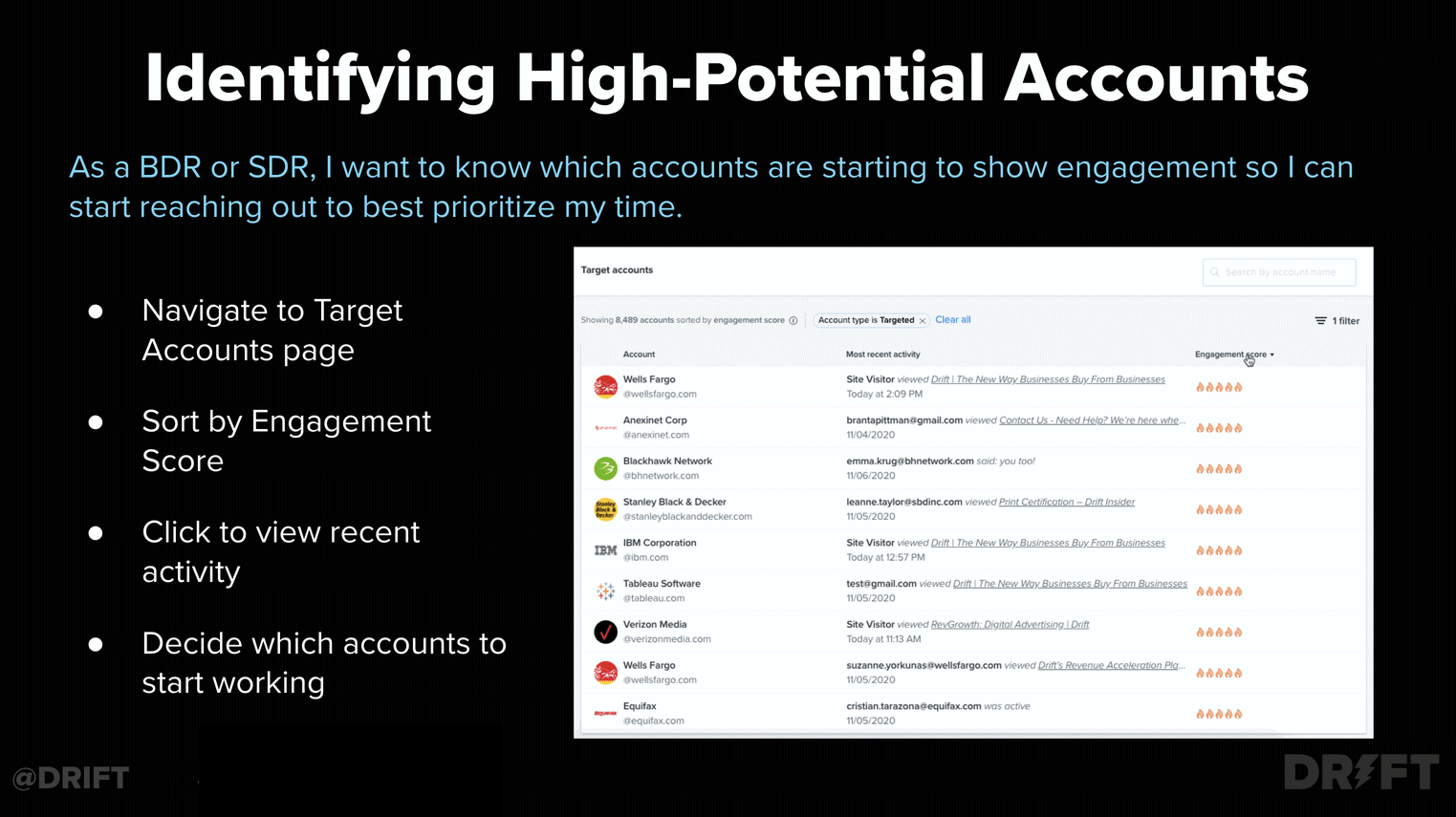
This play pairs your list of targeted accounts with the ones that are hottest right now. Set alerts when targeted accounts swing by the website or when non-target accounts show enough interest that it’s worth following up on.
Intelligent outreach based on engagement gives you the ability to easily see which accounts to start working – and when.
2. Identify the Buying Committee
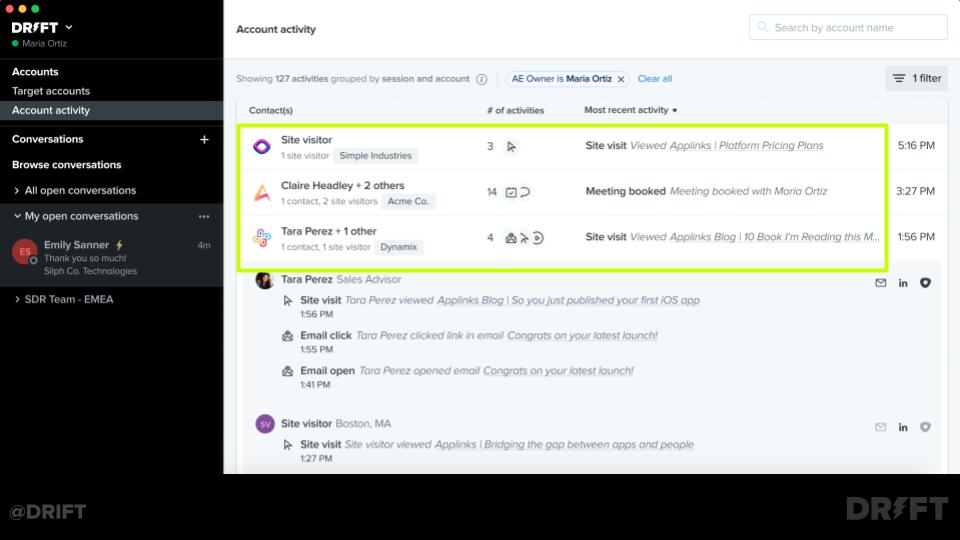
You’re rarely selling to one person when you make a sale. Typically, you’re working with buying committees of six, seven, even eight people that contribute to a decision or influence the outcome.
Not only do you need to figure out who to talk to within the account, now you need to know what role they play in the committee. Who is your champion? Your coach? Your blocker?
So many BDRs blast and hope they land on the right person. And if they don’t, that person will be passing around your email or phone call to the right internal contact.
Drift gives teams the ability to see everyone who comes to your site from a given account so that you can start to understand who you need to talk to and what role they play on the committee, whether you’ve spoken to them on the phone already or not.
That way you can provide targeted, relevant outreach that makes their job as decision-makers easier.
The Prospecting Strategy: Forming the Buying Committee
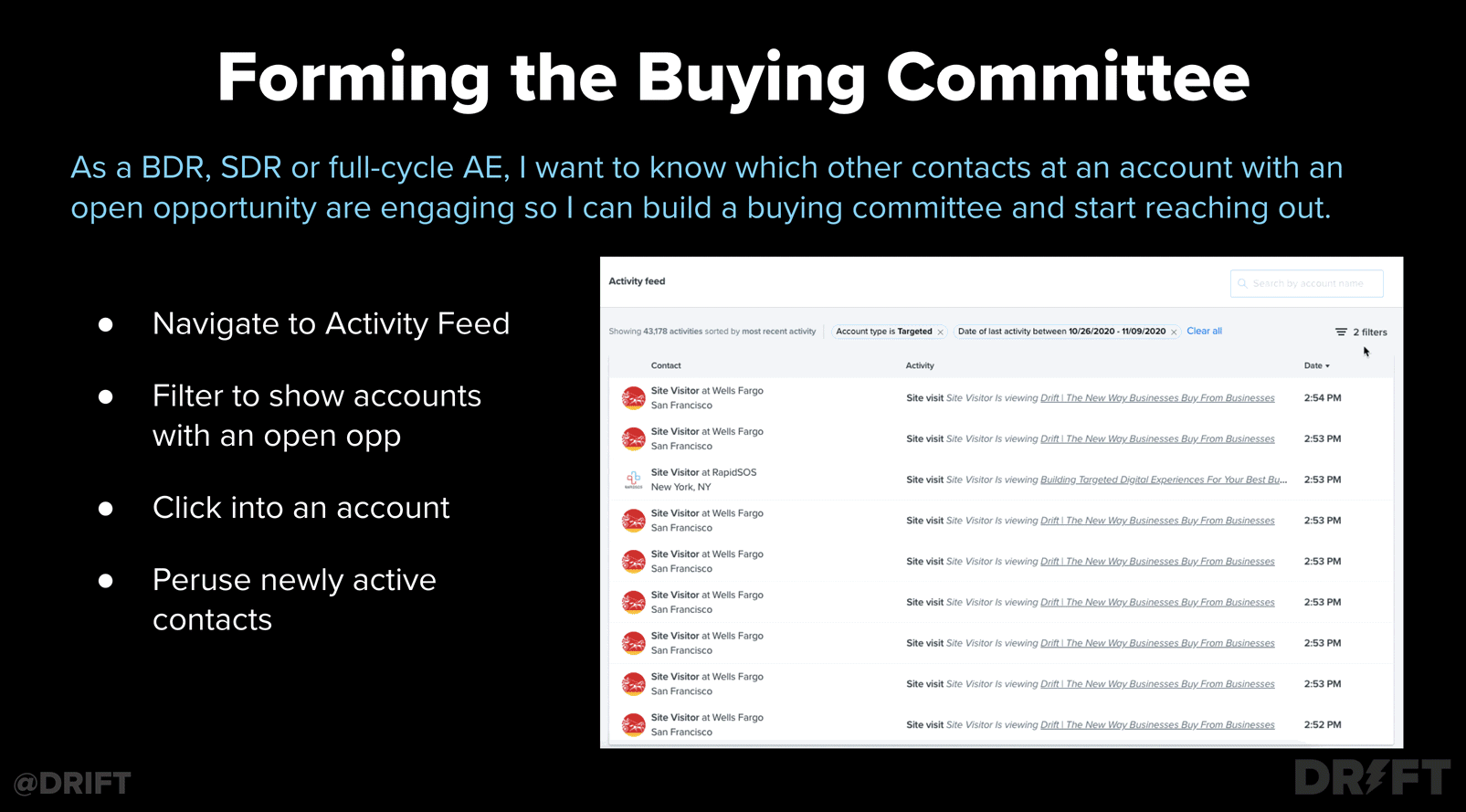
I often push my teams at the outset of trying to get a discovery meeting to reach out to three to five contacts. At Drift, we usually sell to sales and marketing. Of course, that means I want to get CMOs and CSOs on the phone, but I usually also want to talk to someone from operations, someone who leads the BDR team, or someone who leads the demand generation team, because those are all the teams who benefit from using Drift.
This play is where you can take everyone who has shown interest and talk to them all at once, deepening your outreach based on who is engaged and who’s not. That way you can quickly identify who they are, what holes in information you need to fill, and easily engage contacts you may not have spoken with before who are part of an account.
3. Know What to Say When You Follow Up
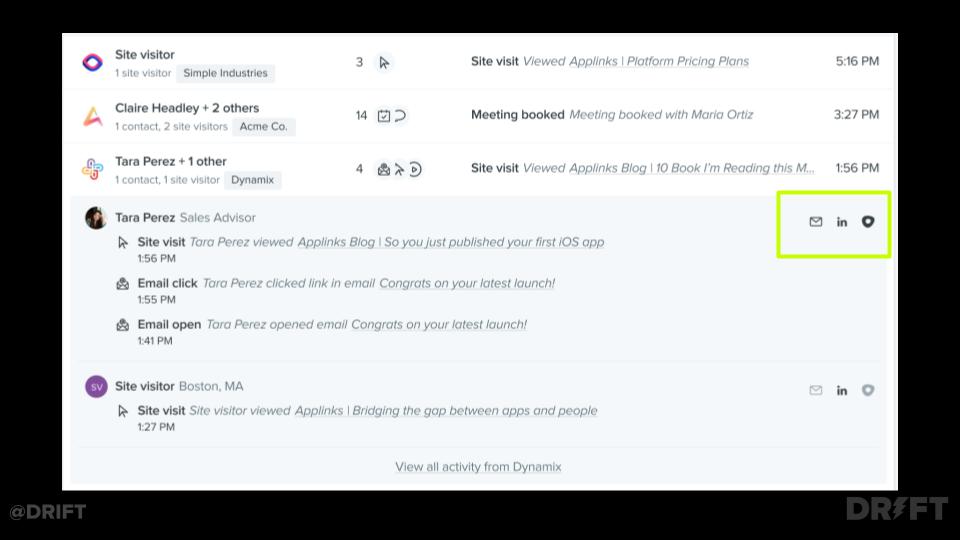
Any outreach you do should be personal.
Personalization isn’t just about the right name or title.
I coach my team at Drift to use three different buckets to achieve it:
- Account history: Have they worked with us before? What have they engaged with? Do they read our emails or blog?
- Job history: How do they describe their role? Where have they worked in the past? What does their LinkedIn look like?
- Account details: What kind of company do they work for? What needs do they have?
With Drift, all of that information is right in front of you.
You can initiate your outreach sequence right from here so you can pick the sequence that directly maps with their interests.
It’s so much more relevant than when you’re just sitting there and blindly following up. Will it be this amazing, magical conversation? No. But it’s much more likely to get the door open and the conversation started, and that’s the real goal.
The Prospecting Strategy: Following Up with Active Contacts
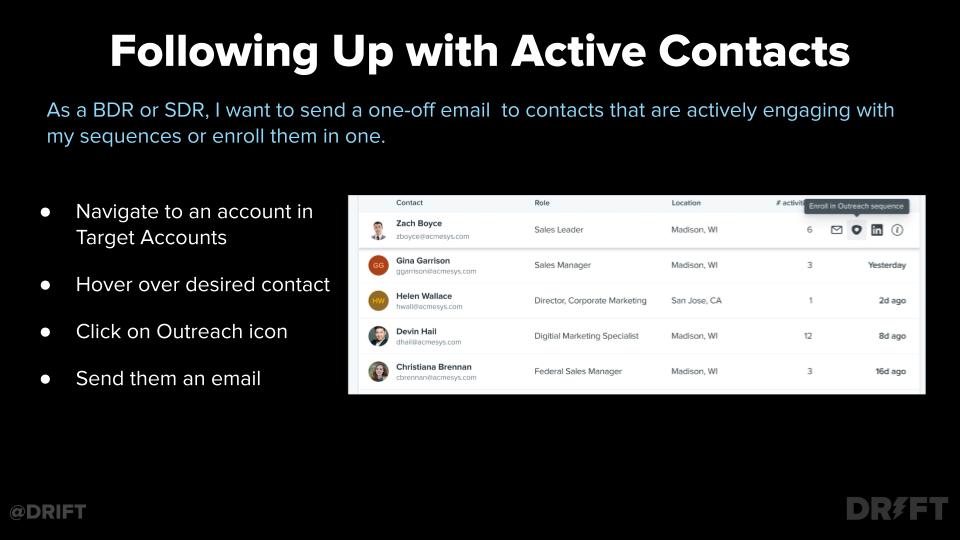
If someone is actively engaging with you already, those are the first people to follow up with.
Nobody gets a sales email and says, “Wow, this SDR just sent me a great email. Now, I’m going to get back to them right away and book a meeting.”
It’s going to take some follow-up.
With this prospecting strategy, you can easily filter to see who has been browsing the site so you can drop them into the most relevant outreach, follow-up, or send a one-off email to keep the conversation going.
4. Capitalize on Buyer Intent
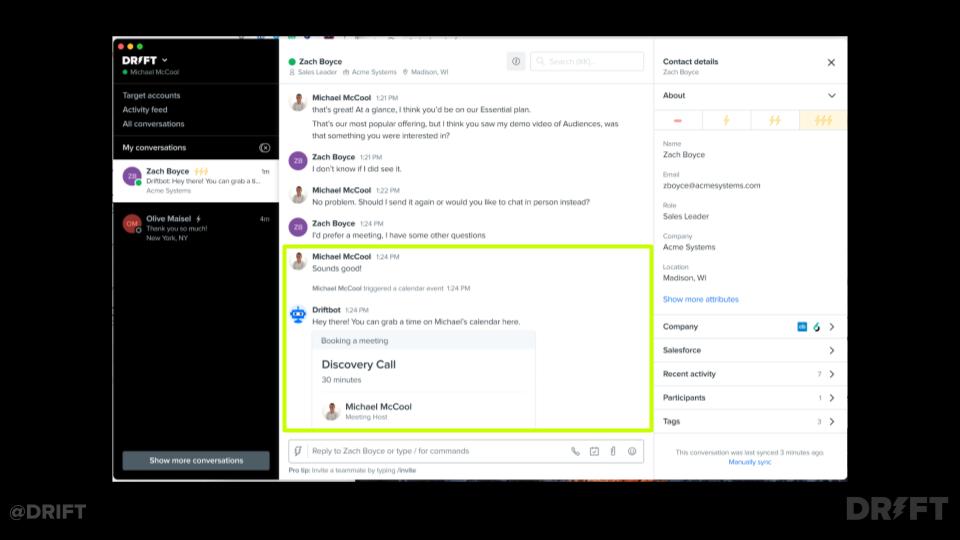
The most sophisticated sales teams leverage buyer intent when they prioritize their accounts.
But it’s also important to consider buyer intent during the deal process. They’ve said yes – now it’s up to you to hammer out those details and close the deal. Accelerating the process by capitalizing on real-time intent closes more deals more quickly.
I know, I know. You might think I’m advocating for sales reps to constantly refresh their Drift pages and just live always-on, right?
Definitely not. That’s the whole point of chatbots. They can pick up the slack while you’re offline or with another client.
Let’s say you see someone from an account that’s been sent over paperwork but hasn’t officially closed come back to your site. That’s the right time for you to jump in and introduce yourself as their dedicated account manager and ask how you can help.
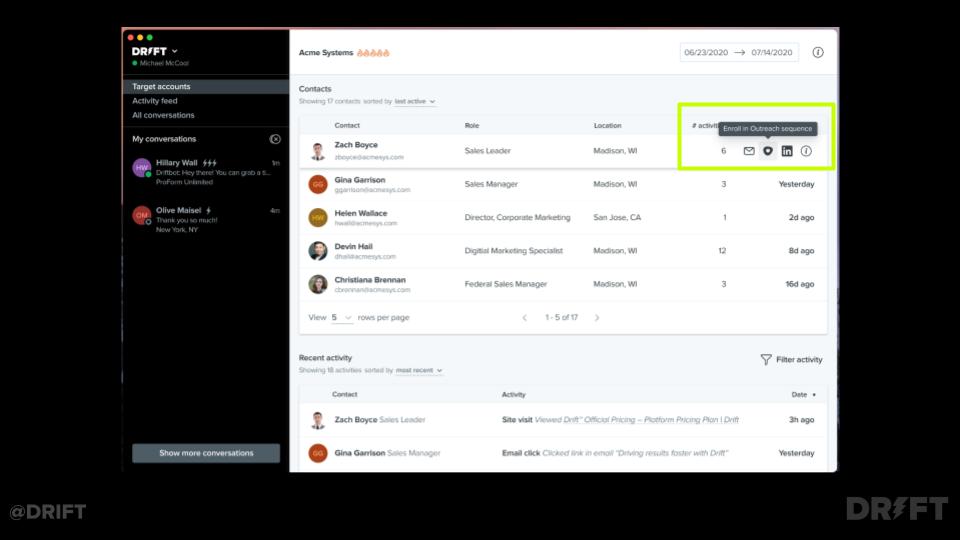
I’ve seen it a million times where someone has a quick legal question and they’re not sure who to ask as you’re hammering out the fine print. Don’t make your customers work for it before the ink is dry. You want to answer any final questions they have like a concierge service, so they can feel confident they’ve made the right choice.
The Prospecting Strategy: Keep Current Opportunities Engaged
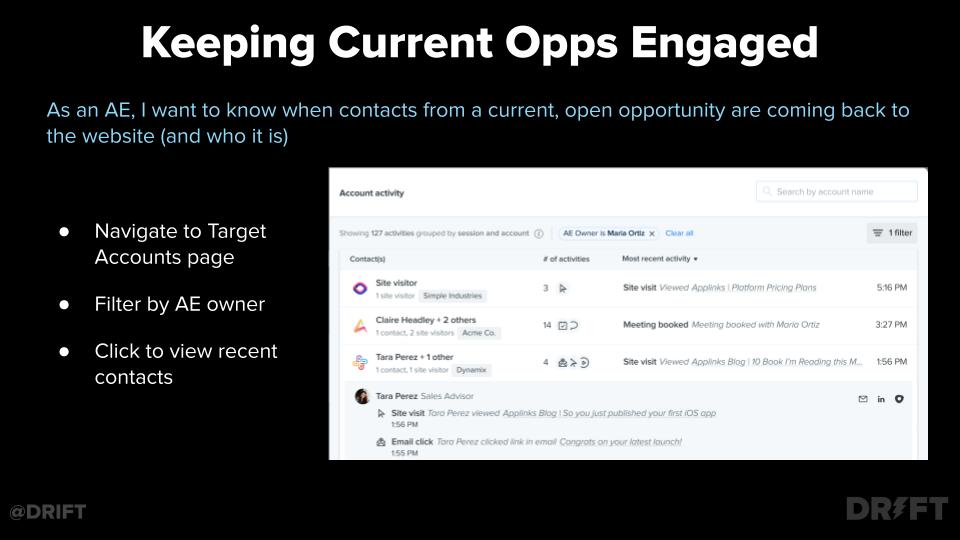
Most of my team here at Drift has between eight and fifteen opportunities running at any given time.
You can’t be everywhere all the time.
With Drift, you can work backward through the sales cycle so you know what’s going on at every part of the buying process and what steps need to be taken next. That kind of deal intelligence takes years of practice to hone…and now, it’s automated with alerts based on which accounts are on the site, what they’re looking at, and levels of engagement that let reps know exactly when to reach out.
Unlocking those final steps can accelerate a deal to close much more quickly. Maybe it’s just looking at the final terms and conditions, or maybe it’s just hoping to schedule one more follow-up call. Either way, you can be where your opportunities are, rather than juggling them all at once.
When your prospect or almost-customer has stopped their day to engage with you, especially when they’re in a deal-cycle with you, you can be there.
With this sales prospecting strategy, you want to make it as easy as possible for them to purchase from you accelerates the process and makes them excited about your offering – a win-win.
We Use Drift Every Day to Accelerate Deals
I’m speaking from experience. Our teams use Drift every single day.
When I found out that nearly 65% of a sales rep’s time (nearly five hours of a given eight-hour day) is spent on non-revenue generating activities, I nearly fell out of my chair.
WHAT.
But as we dug into it, it was true. Our team needed a way to flip that stat.
That’s why we use Drift.
And we don’t use it every single minute. I’d rather have five conversations a day and be in Drift for five minutes than be in Drift for four hours and have one sales conversation a day.
I coach my reps to check it three times a day, right after we wrap up our morning stand-up, post-lunch, and right before we head out for the day. Just 30 minutes – just 6% of a standard eight hour day – of non-revenue generating activities.
That’s a lot more productive time and a lot less non-revenue time.
That way, the team can get back to what they’re best at: building relationships and closing the deal.









